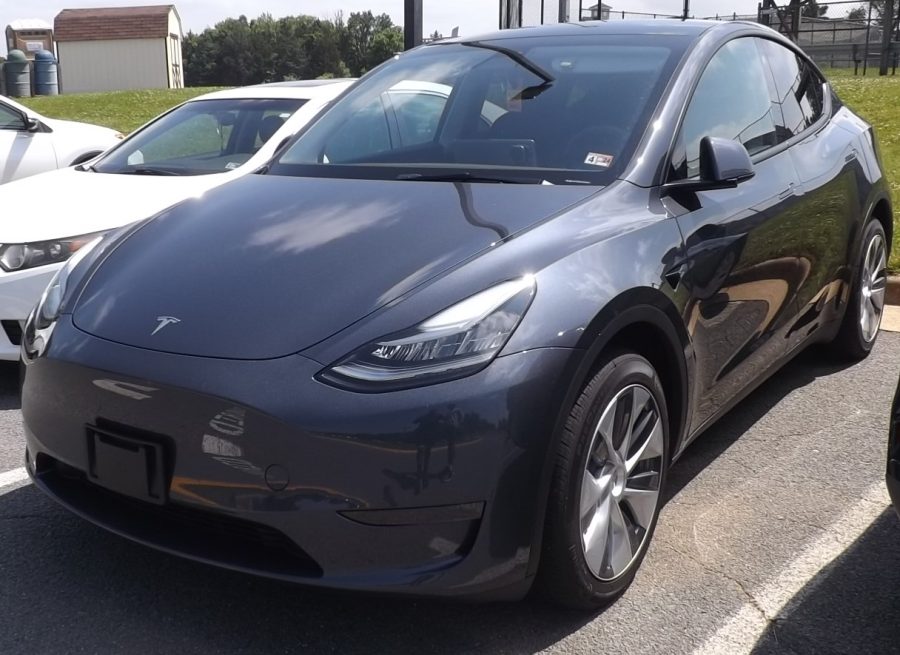The future of electric vehicles is looking bright
Tesla Model Y with a dual motor in a parking lot at Rachel Carson Middle School.
The revving of a quiet, almost soundless engine fills the air as the car silently backs out of the driveway. The car turns onto the road, and unusually, doesn’t leave a smoke trail behind it.
Electric vehicles — known as EVs — are becoming the future of the automobile industry because they are environmentally friendly. Some people believe electric vehicles are good for the environment, but some believe that they are bad for the environment. Madhav Tirumale, a seventh-grader on the Trailblazers team, has a positive stance on electric vehicles, specifically the zero carbon emissions.
“I think they are good for the environment, but the way they are created definitely has some negatives,” Madhav said. “For example, digging for lithium is very bad for the environment and for the people living there, but I think that over time, the EV will compensate.”
Lithium, a critical resource required for electric car batteries, has big environmental impacts that concern people.
“I think there needs to be an alternative to extractioning lithium. I think we need to find a more eco-friendly mineral to make batteries out of,” said Mark Bolt, one of the engineering teachers at Rachel Carson Middle School.. “In the process of refining lithium, a lot of water is used. In South America, a common location of lithium fields, people need that water. So it does not only have environmental impacts, but it also affects people’s well-being.”
Of course, there aren’t only two types of cars, gas and electric. There is also a vehicle called a hybrid car, which runs on both gasoline and electric power. Mr. Bolt thinks that hybrid cars are the way to go.
“If I had to pick, I would select a hybrid. The hybrid has the distance of a gas car and has less emissions like an electric car. The problem is that gas cars have emission issues, and electric cars have distance issues,” Mr. Bolt said. “The hybrid combines both and gets the best of both worlds.”
One key factor when buying a new car for many people is user experience. Comfortability is very important because nobody wants to drive around in a cramped car. Surya Palakurti, a seventh-grader on the Trailblazers team, shares his view on user experience.
“They are usually just luxury, but not enough purpose currently,” Surya said.
Aditya Thaker, an eighth-grader on the Voyagers team, shares similar thoughts as Surya.
“They are smoother than gas cars, and it’s a pain to charge it over and over again because gas cars go farther in one fill than electric vehicles,” Aditya said.
Another major problem with electric vehicles is how the electricity is produced. If the electricity is produced with non-environmentally friendly methods, it just defeats the purpose of electric vehicles.
“Electric vehicles need to be built in with green energy in general,” Madhav said. “There is no point using electric vehicles if the electricity needed for them is produced using non-green methods.”
The Toyota Mirai, a hydrogen powered car, might be a better alternative to electric vehicles such as Tesla’s.
The Mirai boasts a 402-mile range on only battery, compared to Tesla, which goes a little less than 400 miles. Although at the pricey cost of 16 dollars per gallon on the Mirai, it makes up for it with its high efficiency.
The Mirai is also economical, which helps regular citizens be able to afford it. It starts out at $49,500 and goes up to $66,000. With the national average for a car costing $48,000, and the average electric car costing $60,000, the Toyota Mirai falls in nicely with these averages.
“I think electric vehicles are efficient and I believe that they are going to be the main source of travel in the future,” said Aditya.

Seventh-grader on the Trailblazers. Likes reading books, math, coding, playing video games, and American Football.

Bodh Agrawal enjoys playing tennis and football as sports. His favorite dessert is anything with ice-cream, and he likes to go swimming in the summertime.









